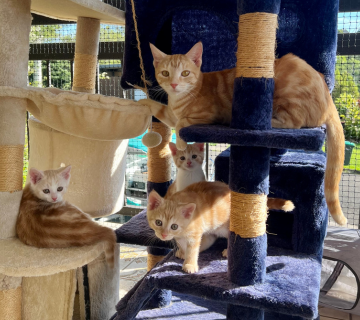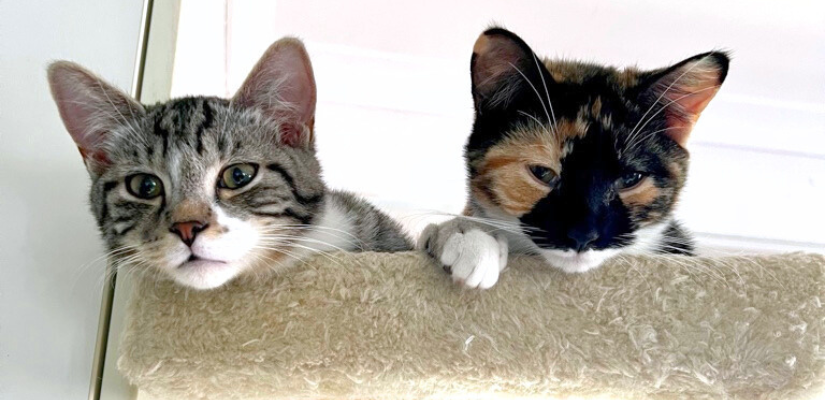You may have looked at your furry friend and wondered what age they might be if they were human. Would you be in the same life stage, or decades apart?
Understanding the age equivalency between cats and humans involves more than a simple numerical conversion, because our lifespans are different at each stage. As we embark on this exploration of the feline lifespan, we’ll unravel the unique journey each cat undertakes.
Cat Years vs Human Years: Decoding the Feline Lifespan
Baby/Kitten Years
In the initial weeks of a kitten’s life, their rapid growth mirrors the intensity of human infancy. These tiny, delicate creatures transform from helpless beings to playful explorers. Physiologically, by one year of age, a cat is comparable to a 15-year-old human.
During this childhood stage, kittens are developing both physically and socially. Their coordination and motor skills improve dramatically. This period is also crucial for the development of social behaviours as they learn to interact with littermates and human caregivers.
Bringing a kitten into your home is akin to embracing the boundless energy and playful exuberance of youth. Kittens, like human babies, require attentive care, a safe environment, and a balanced diet for proper growth. The joy of watching a kitten discover its surroundings and form the first bonds of trust is a uniquely rewarding experience for a new cat owner.
Kittens thrive in homes where there’s ample room for exploration and play. An owner with the time and patience to guide their early development and provide essential training will create a solid foundation for a well-adjusted adult cat.
Teen Years
As kittens transition into their teenage years, their behaviour reflects a mix of independence and youthful exuberance. Ongoing playful antics and exploratory ventures mimic the curiosity and adventurous spirit of human teenagers. Behavioural changes, akin to the teenage assertion of individuality, make this phase dynamic and sometimes challenging for cat owners.
Physiologically, a two-year-old cat is around 24 in human years (their second year is equivalent to 9 human years). While the pace of aging slows down during this second year, this period remains a time of significant development. Cats are refining their hunting skills, establishing territories, and solidifying their personalities.
Opting to adopt a teenage cat means skipping the demanding early phase of kittenhood while still enjoying the vibrancy of youth. Teenage cats are often more settled in their behaviours, making them suitable for owners seeking a balance between energy and stability. A careful socialisation process is crucial during this phase to ensure a smooth transition into a new home.
Teenage cats appreciate a home that offers both stimulation and relaxation. Interactive toys and scratching posts are essential, providing an outlet for their playful energy. An owner who can spend quality time engaging with their teenage cat and providing a mix of entertaining activities and quiet spaces fosters a harmonious environment.
Adulthood
Entering the feline equivalent of adulthood, cats in middle age display a more settled demeanour, now aging at an approximate rate of 4 human years each year. They maintain agility but might not be as energetically inclined as in their youth. The physiological changes during this phase mirror the stability and maturity seen in humans during their middle age. A four-year-old cat is approximately equivalent to a human in their early thirties, embodying a balance between vitality and maturity.
During middle age, cats often achieve their full size, and their personalities become more established. This is a prime time for cat owners to observe and understand their pet’s individual quirks and preferences fully.
Welcoming an adult cat into your home brings the assurance of a more defined personality. Adult cats often have established preferences and behaviours, allowing owners to make an informed adoption choice that aligns with their lifestyle.
Adult cats appreciate a stable and calm home environment. They often form strong bonds with owners who provide consistent care and attention. Comfortable resting spaces, regular playtime, and a well-balanced diet contribute to the well-being of an adult cat. Owners who value a more serene companionship will find this an ideal match.
Getting Older
As cats transition from middle age to their senior years, the signs of aging become more pronounced. Some may experience a decline in activity levels, while others might develop health concerns. The feline transition from adulthood to seniority closely parallels the challenges humans face as they age. Regular veterinary check-ups become crucial during this period to address emerging health issues proactively.
At around 11 years old, a cat is often considered a senior (60+ in human years). Issues like dental health, joint problems, and weight changes may require specific attention. Owners should be attuned to their cat’s individual needs and be proactive in maintaining their health and well-being.
Senior cats offer a unique companionship, characterised by a more relaxed pace and a deep appreciation for comfort. While some senior cats may have specific health needs, their affectionate nature and lower energy levels make them wonderful companions for those seeking a more laid-back feline friend.
They benefit from a quiet and comforting home environment. Owners who understand the potential health challenges of older cats and are committed to providing necessary medical care ensure a fulfilling and comfortable life for their senior feline friends. Soft bedding, easy access to food and water, and regular veterinary check-ups contribute to their well-being.
Elderly Years
In a cat’s elderly years, typically beyond 15 (approximately 80 human years of age), individual health considerations intensify. Elderly cats may require specialised care, including adjustments to diet and increased attention to dental health. Monitoring for signs of arthritis or other age-related conditions becomes paramount.
During this time, cats may experience a decline in sensory functions, such as vision and hearing. Cognitive changes can also occur, leading to conditions like feline cognitive dysfunction. However, with attentive care and a cat-friendly environment, many elderly cats continue to lead fulfilling lives.
The satisfaction of offering comfort and companionship to an elderly cat is a profoundly rewarding experience. Elderly cats may have specific health concerns, but the joy of offering them a peaceful and caring environment is immeasurable.
Elderly cats benefit from a serene and undisturbed environment. Soft, warm places for resting, easily accessible litter boxes, and a gentle, understanding owner who can accommodate their potential health challenges contribute to their quality of life.
How to Calculate Cat Years to Human Years
While the seven-year rule is a common reference, a more accurate calculation involves acknowledging the nonlinear progression of a cat’s age. The best way to calculate a cat’s age in human years is to consider their first year as 15 human years, their second year as 9 human years, and each year beyond that as 4 human years.
So, for a 5-year-old cat, you might calculate their ‘human’ age as such:
CatAgeInHumanYears=15+9+(3×4)
= 15+9+12
= 36

Are you looking to adopt a pet or donate to a pet rescue organisation? Georgie and Cindy from Large Hope SEO foster cats and kittens on the Sunshine Coast in Australia. If you’re local, get in touch to discuss adopting from the rescues. See cats and kittens available for adoption or donate so we can save more kittens.
 seolounge
seolounge